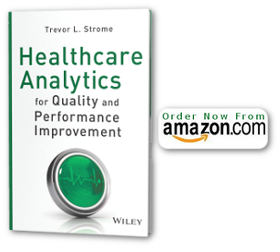This posting is an extracted and abridged selection from my book “Healthcare Analytics for Quality and Performance Improvement”, published by John Wiley & Sons Inc., and available at Amazon.com in hardcover and e-reader formats.
Quality from the patient’s perspective
From the patient’s perspective, healthcare is often thought of in terms of quality and expressed in questions such as, “Which hospital or provider will provide me the best healthcare possible?” Because patients are concerned with receiving high-quality (and affordable) care, quality of care delivery should be of utmost importance to every HCO. Many HCOs stake their reputation on the quality of their care, and patients’ lives literally depend on it. Hospitals, clinics, and providers that are deemed to be of high quality earn stellar reputations, attract patients, are successful at attracting top staff (including both clinical and research professionals), and earn more money, which can be in part reinvested into QI initiatives.
Defining quality in healthcare
What is quality? Some people claim to be able to know quality when they see it when it comes to things like automobiles, clothes, and houses. But how do they “know” quality? In vehicles, the attributes that owners associate with quality range from how solidly the door closes to more quantifiable attributes such as gas mileage. For some people, the perception of quality may all be in the brand name. With regards to everyday items, most people have defined their own sets of desirable attributes and criteria for identifying quality in their favorite products and brands.
The Institute of Medicine defines quality as “the degree to which health services for individuals and populations increase the likelihood of desired health outcomes and are consistent with current professional knowledge.” This definition implies that healthcare is expected to have a net benefit to the patient and that the measurement of quality must reflect patient satisfaction, health status and quality of life measures, and the patient/provider interaction and decision-making process. According to the Institute of Medicine, the provision of care “should reflect appropriate use of the most current knowledge about scientific, clinical, technical, interpersonal, manual, cognitive, organizational, and management elements of health care.”
Going beyond the textbook
A textbook definition of quality provides a starting point, but it is up to HCOs to apply and adapt the sentiments contained within such a definition to their own particular needs and circumstances. Quality has many facets in healthcare, so it is necessary for every HCO to thoroughly understand and define in meaningful terms what quality is to all relevant stakeholders, including and especially patients.
Many HCOs are well-meaning when initiating QI activities but falter because quality is defined in too broad or general terms loaded with good sentiment but little substance. Applying the analytics lens early in the QI process helps to remind quality stakeholders that quality must be defined in terms that are quantifiable—meaning they can be measured, monitored, analyzed, and acted on.

{ 0 comments… add one now }